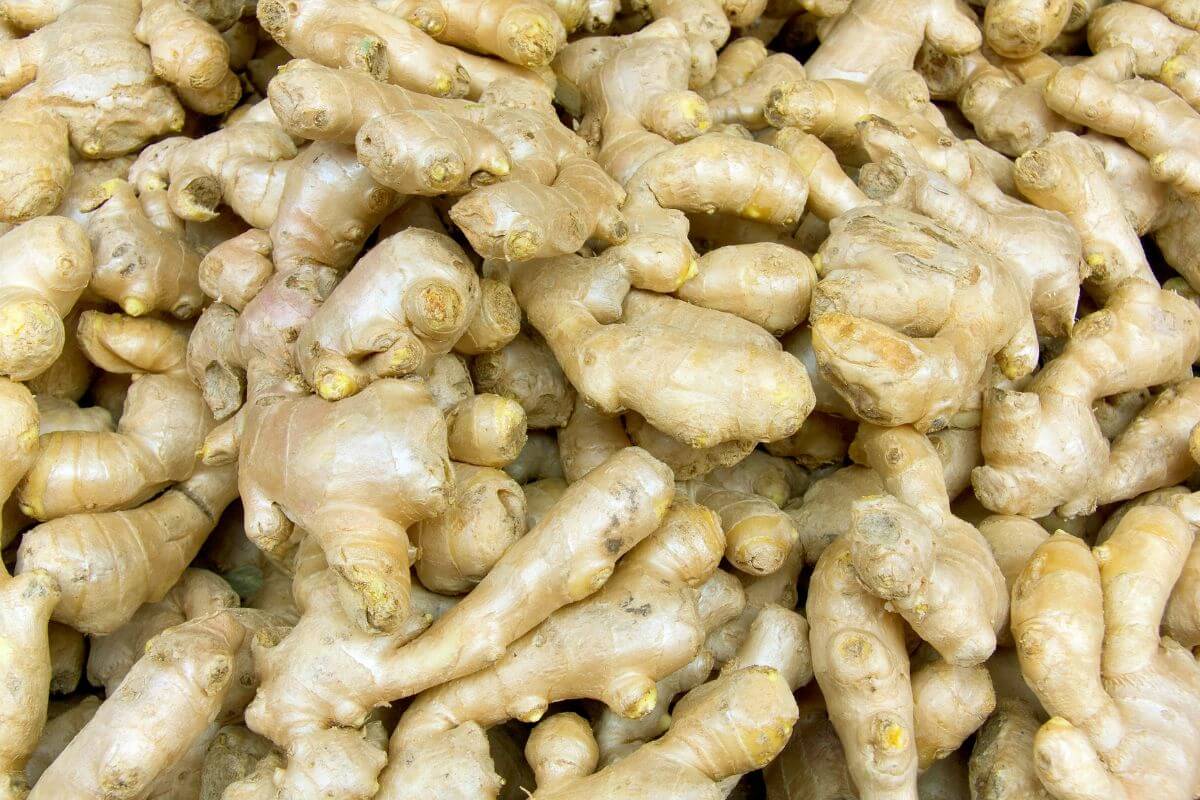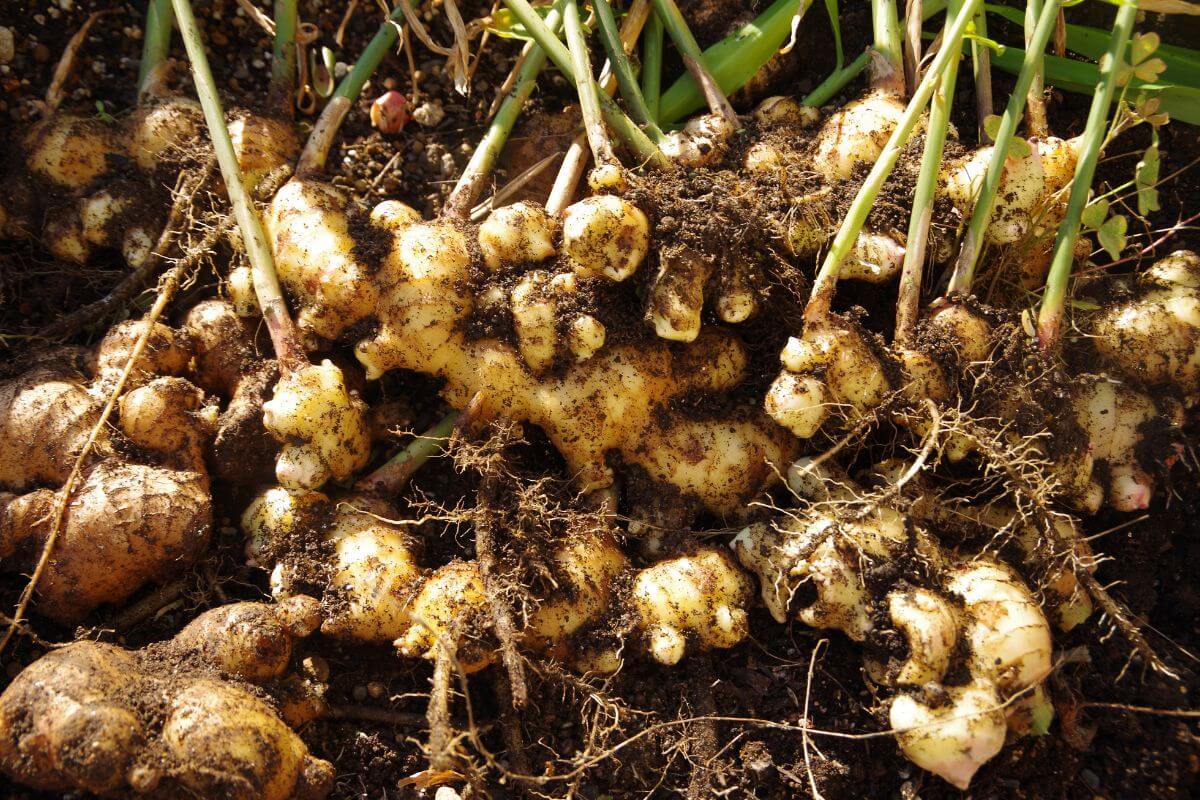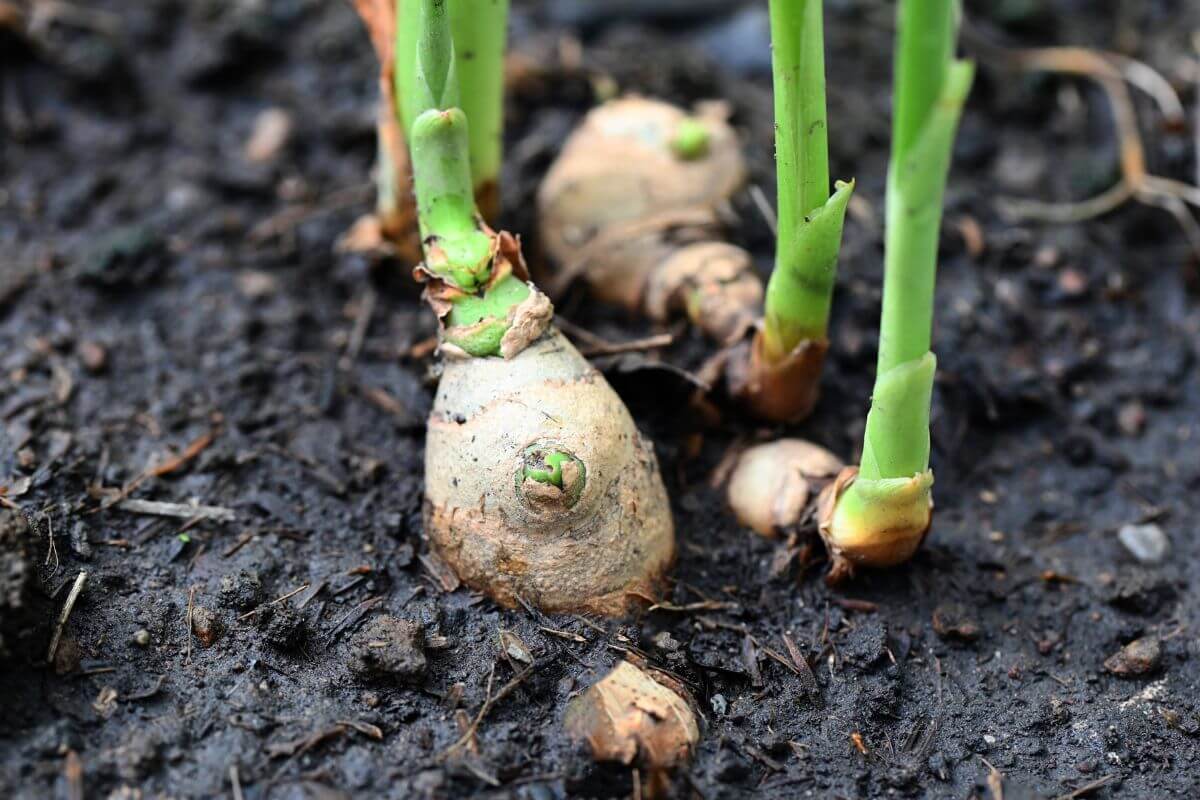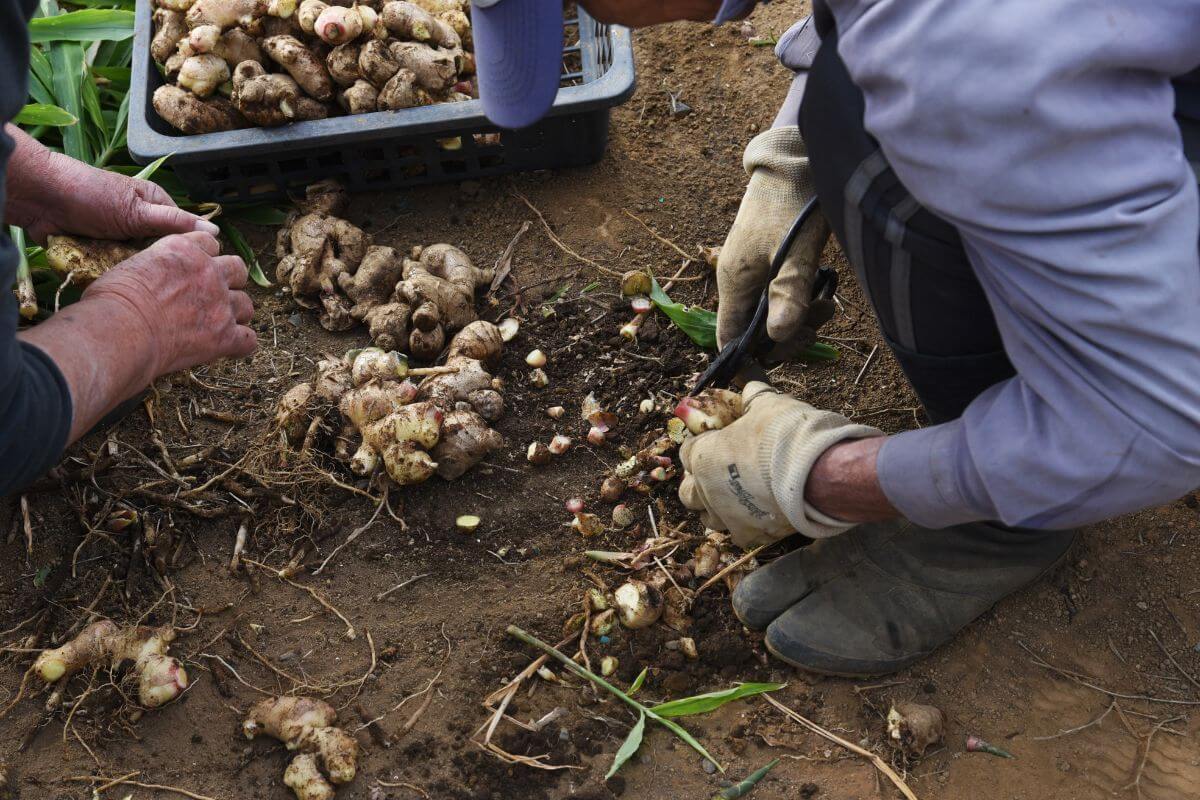When I grew my first ginger plant, I was convinced that it would be difficult and that I would probably fail. Guess what? It’s not very difficult and not only did I not fail, I now, cultivate several ginger plants in my garden.
Ginger is becoming ever more popular for home gardeners thanks to its numerous health benefits, including improving your immune system and gut health, and giving relief to digestive ailments.
This article will cover how to grow ginger and care for it.
Ginger Overview

Ginger is a spicy herb (vegetable) that is used in both Asian and Indian cuisine. It’s the underground root of the vegetable that is used in various forms, including dried, powdered, and in oil. Fresh ginger can even be consumed as-is.
Because this vegetable is a tropical plant, it cannot survive in areas subject to frost. If you reside in the tropics, you can plant your ginger at the beginning of the wet season.
For harsher climates, ginger should be planted at the beginning of spring, but after the last frost. This is a slow-growing tuber, so it will take some time to grow them.
If you enjoy cooking and growing your own herbs and spices, add culinary ginger to your gardening list.
How to Grow Ginger Guide
If you want to grow ginger yourself, beginning is quite easy. Read on to start cultivating your own homegrown ginger.
Choosing the Ginger Root to Plant
Be careful with choosing just any ginger, including ginger plants that bloom, because many are species that are inedible and are generally used as ornamental plants.
Also, consider choosing organic ginger as there won’t be residue from chemical fertilizers or pesticides. Non-organic ginger also might be sprayed with a growth inhibitor because people may be averse to buying ginger that’s sprouting.
You can purchase ginger root plant from your local grocery store. If you want to grow ginger for food preparation purposes, the most popular ginger species is Zingiber officinal.
You will need a ginger root or rhizome. These usually have a plump, somewhat rounded appearance and feature small eyes. If you find a ginger rhizome where the eyes of the root have begun to turn green, this is an ideal specimen to begin with.
If you’d like to grow more than one ginger plant, it is not necessary for you to buy multiple ginger tubers. You can slice a single ginger root into several pieces with a sterilized sharp knife.
When preparing your pieces to plant, pieces ideally should be 1 to 1.5 inches in width and feature at least one, if not more, eyes to grow a new plant. Pieces with three ginger eyes or more have a better chance of sprouting.
Once you have prepared the pieces, set them aside and leave them in a dry place for several days until they form a protective callus on their surface and heal from the cuts. This is important for avoiding infections.
Soil Preparation for Ginger

For successful ginger cultivation, well-draining loamy, rich soil is a must. One part garden soil with one part compost will get your plant or plants off to a healthy start.
If your garden soil is clay-based or poor in nutrients, try mixing rich potting soil to compensate for the lack of nutrients.
Ginger will thrive in a soil bed that is somewhat acidic with a pH level between 6.1 and 6.5. If your garden soil tends to be more alkaline, you can adjust this with pH store.
If you want to begin with a starting tray of ginger indoors, before transplanting your plants outdoors, that will work. Fill the tray with coconut fiber or sphagnum moss as they drain exceptionally well and will help prevent root rot in your young plantlets while waiting to transplant.
When you prepare to plant your ginger pieces in the ground or in a container, they will need about 8 inches of space between them. Position the ginger 2-4 inches deep.
Pieces should be placed with the buds pointing upwards in loose soil. If you are cultivating in a pot of soil, use a large plastic one with drainage holes. Limit the planting to three pieces at the most.
When growing ginger in the ground, mulch heavily. Your ginger plant will appreciate a spring feeding with a fertilizer that has high phosphorous content.
Light for Growing Ginger
Ginger likes lots of light, but prefers a dappled sunlight or a partial shady spot. It can manage direct sunlight if exposure is limited to the morning hours.
- Related article: Growing Herbs Indoors Without Sunlight
Water and Humidity for Growing Ginger

Ginger likes lots of moisture. Once your ginger is planted, keep the soil moist. Water lightly immediately after planting.
Be sure to check the soil and water add water before your soil bed dries out completely. Should you notice that your soil has poor drainage, reduce watering to avoid waterlogged soil. If you overwater, the water will drain away soil bed nutrients.
Humidity is a favorite of the ginger plant. If you live in an area with dry air or your home has dry air, misting ginger regularly to increase humidity will help.
- Read more about humidifiers for plants.
Climate and Temperatures for Growing Ginger
Zingiber officinale does well in USDA growing zones 9 to 12, but a few varieties may do well even in zone 7. However, since zones 7 and 8 have damp winters, ginger is usually harvested here in late autumn, whereas in zones 9 to 12 it can be harvested throughout the year.
The ideal soil bed temperature should measure somewhere between 71° to 77° Fahrenheit while waiting for your ginger pieces to germinate. Once planted, it’s important to keep an eye on your ginger, especially during cold weather months.
If you live in a zone that has a winter, I suggest you bring your ginger inside and store it somewhere warm and dry. If this is not an option and you leave your ginger outside, cover the plant with a heavy layer of mulch if temperatures fall below 50°F.
Growing and Caring for Ginger
Now some people suggest soaking ginger rhizomes in warm water overnight due to growth retardant treatments practiced on store bought ginger. Personally, I positioned my rhizome pieces directly in warm moist soil, and they rooted very easily.
The best period for planting is at the end of winter or in the early spring, which is the same as the end of a tropical dry season or the beginning of the wet season.
These plants also need to be protected from high winds. If your ginger tuber remains underground to develop, it will achieve a stronger taste.
Any rhizomes that you replant or leave in the ground after harvesting will not require care until the weather warms up.
To grow ginger in a container, choose a flat, wide pot because these tubers grow horizontally. Width will be more important than depth.
How to Harvest Ginger

At the end of the tropical wet season or summer, the weather will begin to cool and ginger plants will die back.
Reduce your watering, even allowing your soil bed to dry out. This will assist the ginger in developing rhizomes.
When all the ginger foliage has died, you can harvest. Ginger will generally need eight to ten months before they’re mature enough for harvesting.
To harvest ginger:
- Dig up the entire plant.
- Break the rhizomes into parts and select a few with growth buds for replanting.
Ginger rhizomes can be peeled, chopped, and then frozen. Still, other people like to store ginger chunks in brandy to keep it fresh.
Another harvesting method is to grow clumps of ginger and just dig up or remove what you need as you need it.
Mature rhizomes will grow outwards, sprouting new shoots. You can cut out the mature rhizome in the middle and leave the outer shoots to continue growing.
Ginger Pests and Diseases
Ginger plants are susceptible to a variety of diseases and numerous pests. Among the diseases we find:
- Bacterial wilt
- Fusarium Yellows fungus
- Root-knot nematode
Common pests that may affect your ginger plant include:
- Mealybugs
- Aphids
- Ants
- Cardamom thrips
- Soft scales
- Chinese rose beetles
- Red spider mites
- Fijian ginger weevil
Growing Ginger Final Thoughts
Ginger is one of those spices that everyone loves but no one really knows how to grow. It’s easy to buy pre-ground spice mixes, but nothing beats freshly grown ginger!
Growing your own ginger is fun and rewarding. It can also be a fun project with the kids. The first time you bite into a piece of homegrown ginger, you’ll know why so many cultures have enjoyed its flavor for centuries.
Growing Ginger FAQs
Can you plant ginger root from the grocery store?
Yes, you can purchase a ginger root from your local grocery store and plant it. However, if you do this, make sure you get organic ginger, so there are no growth inhibitors sprayed on it.
How long does Ginger take to grow?
You should expect about 8 – 10 months before harvesting. It is a slow-growing tuber.
What month is ideal for planting Ginger?
Ginger tuber or rhizome pieces are best planted in the early spring after the last frost.
Should I soak ginger before planting?
If you can acquire organic, fresh rhizome from another gardener, no. If you are growing store-bought ginger, you can soak the tuber overnight as some may be treated with growth retardant before selling.
How do you know when ginger is ready to harvest?
Ginger will be ready for harvesting after blossoming and at least ten months after sprouting. Leaves will have dried and yellowed with stems drooping.
Does ginger need full sun?
No, ginger does not do well with direct, full sun exposure. Dappled sunlight is best for ginger as it’s similar to its native environments.
What is the best container for growing ginger?
A flat, wide pot is recommended as ginger tubers grow horizontally. Width will be more important than depth when it comes to the best container for growing ginger.
What do you mean by “peel” when talking about Ginger?
When you peel Ginger, you are removing the skin. Peeling ginger is done primarily for cooking purposes, similar to potatoes.
Do you have any tips for keeping Ginger healthy?
A couple of the top tips for keeping ginger healthy is to keep the soil moist and free of weeds. Keep your garden well watered, so it always has water to absorb nutrients and keep growing. Keep the area around your ginger free of weeds, so that there is no competition for nutrients.


